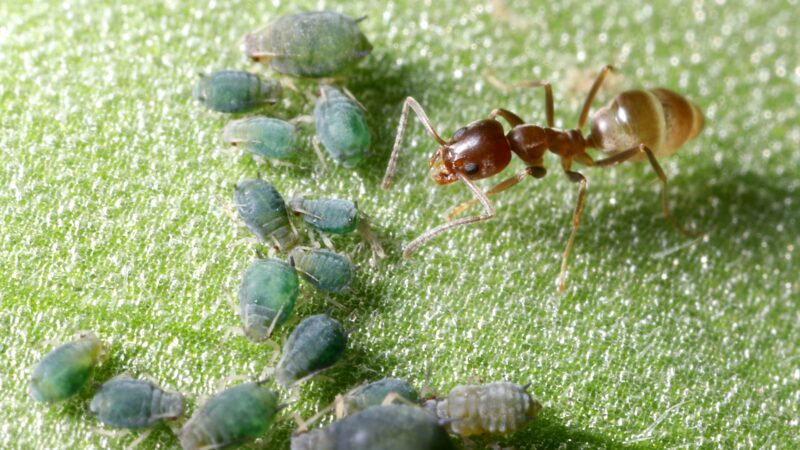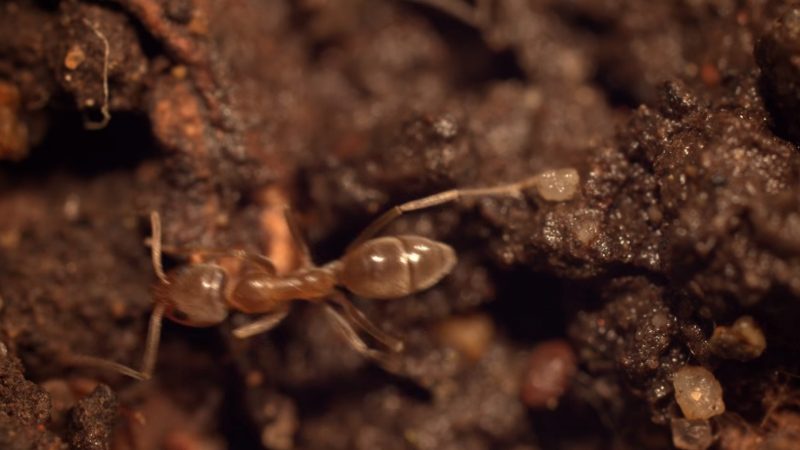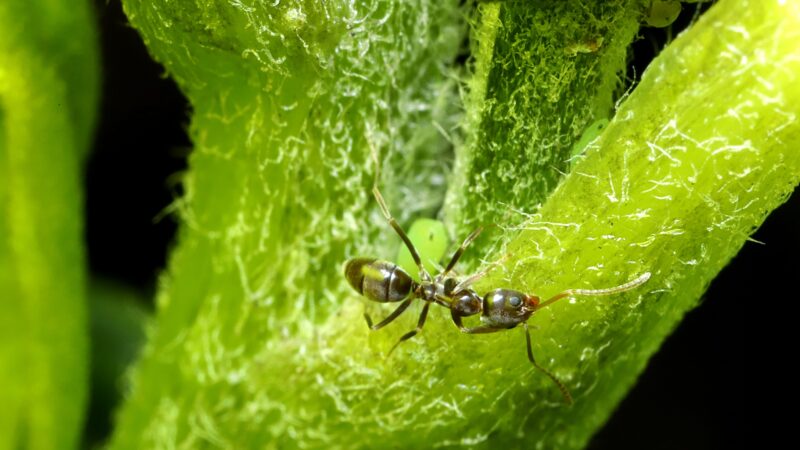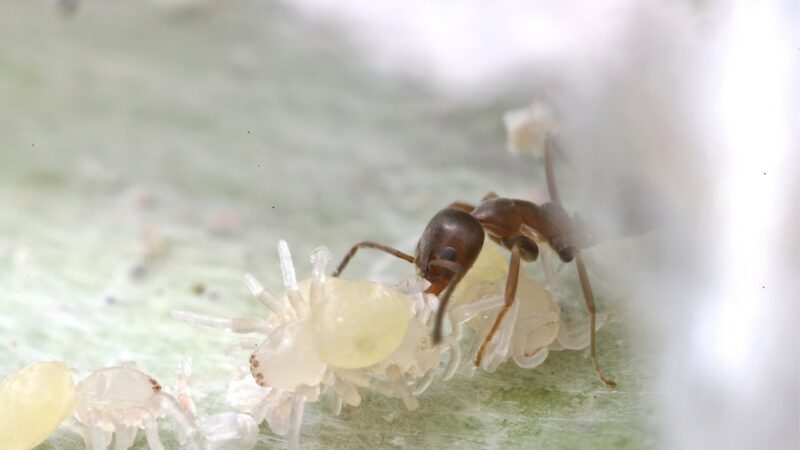Argentine ants, originally from South America, are a globally known pest due to their transportation by human activity. They often infest homes and other buildings in search of food and water. If you find Argentine ants in your home, it’s important to act fast to get rid of them as they reproduce rapidly, with multiple queens per colony.
To eliminate Argentine ants, remove their food and water sources, locate and remove the nests, and use bait stations containing a slow-acting poison. Using insecticides, such as boric acid, around your home’s perimeter will prevent re-infestation.
It’s essential to take Argentine ants seriously as they are attracted to waste and decaying matter, which can spread dangerous bacteria over your food and cause serious health problems. In the following sections, we provide a step-by-step guide on how to get rid of them and important information on identifying them and other ant species.
Argentine Ants Identification: Information and Facts

What Are Argentine Ants?
Argentine ants are an invasive ant species native to several countries in South America. They are known for their adaptability and very large colonies, which can now be found on several continents. They are average in size and appearance compared to other ant species and are light to dark brown.
Where Do They Live?
Today, Argentine ants can be found in Australia, Europe, Africa, North America, Hawaii, and New Zealand. They prefer warm, wet climates. If they reach the inside of your home, they will be attracted to moist areas such as sinks, house plants, and leaky pipes.
How Long do They Live?
Argentine ants can live a relatively long time compared to other ant species. Under the right conditions, Argentine ant workers can live up to one year, and their queens can live several years longer. That’s significantly longer than some other ant species workers, who, depending on their role in the colony, may only survive for a matter of weeks.
Related: How Long Do Ants Live | Ant Lifespan: Information and Facts
Life Cycle
Argentine ant eggs hatch after about 28 days. After hatching, it takes approximately 75 days for the larvae to mature fully. Queens of Argentine ants only need to mate one time to continue laying eggs for the rest of their lifespan.
What Do They Eat?
Argentine ants are mostly attracted to sweet, plant-based foods. They will also eat “honeydew,” sweet liquid aphids produce. Although Argentine ants prefer sweet substances over anything else, they will also eat oily foods.
Related: What Do Ants Eat? | Ant Feeding Habits
Argentine Ant Size
Argentine ants are approximately 2.2 to 2.8 mm (0.0866142 – 0.110236 inches) long, which is average-sized in the ant world. The queens are about 6mm long, which is small compared to the queens of other ant species.
Related: Ant Size Chart and Comparison: Information and Facts
What Causes Argentine Ants?
Argentine ants may invade your house or yard for a number of reasons. They disperse naturally over time, but certain conditions can draw them in and make your areas a good place for them to nest. Moisture. They are drawn to wetness, so puddles in your yard may be luring them in.
- They might be drawn to any leftover food in your home, including dried spills.
- Like many other species, Argentine ants favor warm temperatures. They might seek refuge in your house if the weather is chilly.
- Ants may be drawn to them if you have an infestation of other insects that Argentine ants generally cohabit with, including mealybugs or aphids.
Are Argentine Ants Harmful to Humans?
Argentine ants provide less of a risk to people than they do a nuisance. They reproduce swiftly, and colonies of them can number in the hundreds of thousands.
Super colonies can be formed by connecting many colonies. This may cause extensive infestations. These ants will break inside houses in search of food. They can spread disease if they crawl through rubbish before landing on food or countertops.
Do Argentine Ants Bite?
While not aggressive, Argentine ants will bite if they feel threatened. Unlike many other ant species, Argentine ants do not have a stinger on their thorax.
Argentine Ant Bite Treatment
While the argentine ant’s bite is not poisonous or dangerous, its bite could lead to complications like infection or anaphylactic shock. To prevent infection, wash the area thoroughly with soap and water, and use a spray disinfectant if possible.
Keep the area clean during the healing process, and avoid scratching. Scratching creates tears in the skin and transfers harmful bacteria from your fingers into the wound, leading to infection.
If you believe your ant bite is infected, see your doctor. It’s also important to be aware of the signs of anaphylactic shock. Anaphylactic shock is a rare but serious condition that insect bites can trigger. Signs include swelling of the tongue, lips, or throat, tingling hands or feet, and difficulty breathing. If you observe any of these symptoms, seek immediate medical attention.
How Did Argentine Ants Get Into My Home?
Due to their opportunistic nature, ants will enter a house through whatever gaps and fractures they can find. They may use it as a way to enter your home if tree branches, plants, or shrubs are in close proximity to the side of your house. If they discover moisture and food once inside, it will be challenging to persuade them to leave.
How to Get Rid of Argentine Ants? | Step-by-Step Instructions

So, how to get rid of Argentine ants? Follow these steps to remove the Argentine ants from your home and prevent them from returning.
Step 1 – Identify the Root of the Problem
If you are dealing with an Argentine ant infestation, you can be certain that they’ve found a source of food and/or water in your home. First, check all of the food stored in your house. This includes opened packages and sealed food that may have damaged packaging.
After you’re sure that the food in your home is sealed up and secure, check for any water sources. Something as simple as a leaky pipe or water in the base of a potted plant could be enough to attract Argentine ants to your home.
Step 2 – Wipe Down All Surfaces in Your Home and Take out the Garbage
Leftover crumbs or sticky remnants of spilled juice will be enough to catch the attention of Argentine ants. Leftover food in trash cans is also a food source for these insects. Use a 50% water and 50% vinegar solution to wipe down all surfaces in your home, including floors and trash cans. The water and vinegar solution will erase the argentine ant’s chemical trails (called pheromone trails) which they use to lead other ants to food sources.
Note: Some surfaces, such as stone and hardwood floors, should not be cleaned with vinegar. In this case, use a specialized cleaner made for that surface.
Step 3 – Set up Ant Baits
When it comes to battling an Argentine ant infestation, ant baits are the most effective method available. Ant baits contain an ingredient that is mostly harmless to humans but deadly to ants.
The ants will carry the pieces of bait back to their nest, believing it to be the food for the colony. The bait is then shared with the rest of the colony, and when ants and their queens consume the bait, it will eventually destroy the whole colony.
How to Kill Argentine Ants? | Best Ant Killer Products
Here are some of the best products available that can be used for argentine ant infestation.
Best Ant Baits for Argentine Ants
- ATTRACTS & KILLS: TERRO liquid ant baits indoor effectively...
- KILLS THE ANTS YOU DON'T SEE: TERRO ant bait is designed to share...
- FAST-ACTING: Noticeable ant activity reduction within days as...
- READY TO USE: Simply place ant baits indoors with no setup...
- VERSATILE HOME PLACEMENT: TERRO ant traps are ideal for use along...
- One 8 count package of Raid Ant Killer Baits protects against...
- Raid Ant Killer works for up to 3 months to help control ants in...
- This pest killer comes in convenient Raid Ant Traps where ants...
- Raid Ant Killer is ideal for use throughout your home, including...
- Try other Raid bug spray and insect killer products for all of...
- ATTRACTS & KILLS: Effectively targets and eliminates common...
- KILLS THE ANTS YOU DON'T SEE: Terro ant bait is designed to share...
- FAST-ACTING: Noticeable ant activity reduction within days as...
- READY TO USE: Simply place ant baits indoors with no setup...
- VERSATILE HOME PLACEMENT: Ideal for use as terro ant traps along...
DIY Ant Bait | Argentine Ants Boric Acid
You can make your ant bait using boric acid. This fine powder of boric acid can be easily mixed with jelly, honey, or peanut butter. Use one teaspoon of boric acid per cup of food. Place the mixture in a container with holes and place it where you found Argentine ants in your home. For safety reasons, ensure the container is marked as ant bait.
These homemade ant baits work in the same way as the bait you buy at the store. Ants will bring the food and the poisonous boric acid back to their nests to share with the colony. Eventually, the entire colony will be killed.
How to Get Rid of Argentine Ants Naturally?

If you prefer a more natural route, there are plenty of alternative ways to deal with an ant infestation. Here are a few things you can try:
Spices
If you have cinnamon or mint in your home, you already have a natural ant deterrent! Sprinkle cinnamon around the areas where you’ve found Argentine ant trails or bundle mint leaves together and leave them in areas where you’ve seen ants entering your home.
Dish Soap and Water
Mix one-part dish soap with three parts water. Use a spray bottle to spray the solution directly on the Argentine ants. The mixture will cling to the ants’ exoskeletons, causing suffocation.
Baby Powder or Chalk
Baby powder and chalk are known to deter ants. It is unclear why ants will do anything to avoid these products. Sprinkle the baby powder around entry areas of your home or draw chalk lines on hard surfaces that you don’t want ants to cross.
Diatomaceous Earth
Diatomaceous earth is an all-natural product made from the fossils of sea algae and other tiny sea organisms. It kills ants by contacting their exoskeletons and drying them out. Diatomaceous earth can be found at most home improvement and gardening stores.
Related: Best Natural Ant Sprays | Kids and Pet-Friendly Sprays
How to Prevent Argentine Ants?
- Remove all sources of food and water. Ants are less likely to visit your home or garden if there is no food or water for them to forage on. Never leave any food or water out in the open, even rainfall, and always cover any outdoor trash.
- Keep the debris out of your yard. In heaps of wood, mulch, grass clippings, and other yard waste, Argentine ants will build their nests. You may keep them away by keeping it clear and storing any required firewood far from your house. The recommended distance is twenty feet.
- You can keep Argentine ants out of your home by promptly cleaning up accidents, routinely getting rid of trash, often wiping down countertops and other surfaces, and storing food in sealed containers.
- Keep your yard and the area around your house secure. If ants haven’t already moved in, you may keep them out of your home with regular applications of diatomaceous earth or long-lasting insecticide sprays that will kill them instantly.
- These ants prefer wet surroundings. Reducing moisture accumulation can aid in keeping them at bay. By clearing flowerpots, buckets, and other water-collecting devices from the area around your home, you can eliminate standing water. Fix or replace leaking faucets and pipes.
How to Prevent Argentine Ants From Spreading?
It’s crucial to keep in mind that Argentine ant colonies can contain numerous queen ants when trying to eradicate them. If you try to remove a nest, it can break up into smaller colonies, which would exacerbate the issue. As a result, there are a few things you should refrain from doing.
- Avoid attempting to flood or drown an Argentine ant nest. Because of the shallowness of their nests, any survivors will split off and start new colonies.
- Avoid spraying the nest. Using standard insecticides to spray the nest will have the same result as flooding in terms of increasing the number of nests.
- Avoid using insecticides that repel people. Argentine ants will split off into separate nests if any repellents are employed to attempt to control them. They may also become panicked and produce more eggs as a result.
Argentine Ant Facts

Argentine ants may look similar to other ant species, but several interesting things make them stand out.
Remarkable Argentine Ant Queens
Argentine ant queens are unique in several ways. Argentine ant colonies contain the highest queen-to-worker ratio of all ant species. The queens are also mobile, allowing them to do more than lay eggs.
They are known to feed their own young. In other ant species, this task is left exclusively to worker ants. Such mobile queens allow the Argentine ants to move their entire colonies when threatened quickly.
Super Colonies
Argentine ants are responsible for building the largest ant colony ever discovered by man. In 2000, a colony was discovered in southern Europe stretching for 3,700 miles.
Strange Odor
When Argentine ants are crushed, they let off a musty smell. Only one other species of ant, the odorous house ant, lets off a similar smell when crushed.
Peacemakers
Although argentine ants make up some of the biggest colonies in the world, they are not as aggressive as other ant species. Most ant colonies, even those of the same species, will go to war with each other over territory. However, this is extremely rare for Argentine ants. When they encounter another Argentine ant colony, they commonly integrate the foreign colony into their own simply.
If you think you can’t handle your ant infestation, please call professional ant exterminators, as they will solve your problem within a day or two. For more pest-related content, please keep following our site!
List of Sources
Cooling, M., Hartley, S., Sim, D. A., & Lester, P. J. (2012), The widespread collapse of an invasive species: Argentine ants (Linepithema humile) in New Zealand, Centre for Biodiversity and Restoration Ecology, Victoria University of Wellington, New Zealand
Suhr, E. L., O’Dowd, D. J., McKechnie, S. W., & Mackay, D. A. (2011), Genetic structure, behaviour and invasion history of the Argentine ant supercolony in Australia, Evolutionary applications, Australia
Silverman J., Brightwell R.J., The Argentine ant: challenges in managing an invasive unicolonial pest, Department of Entomology, North Carolina State University
- How to Get Rid of Copperheads | Practical Guide - August 27, 2023
- How to Get Rid of Corn Snakes | What Makes Them Aggressive? - August 27, 2023
- How to Get Rid of Alligators | Safety Measures and Removal Methods - July 16, 2023



